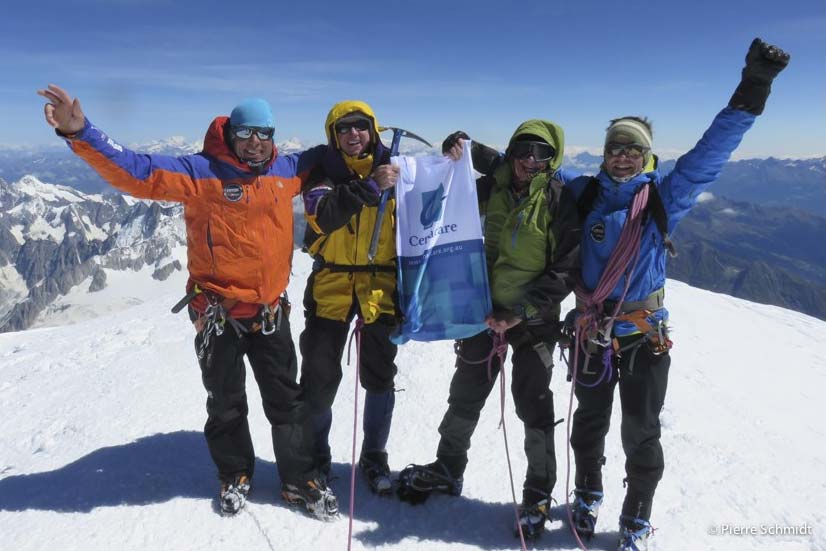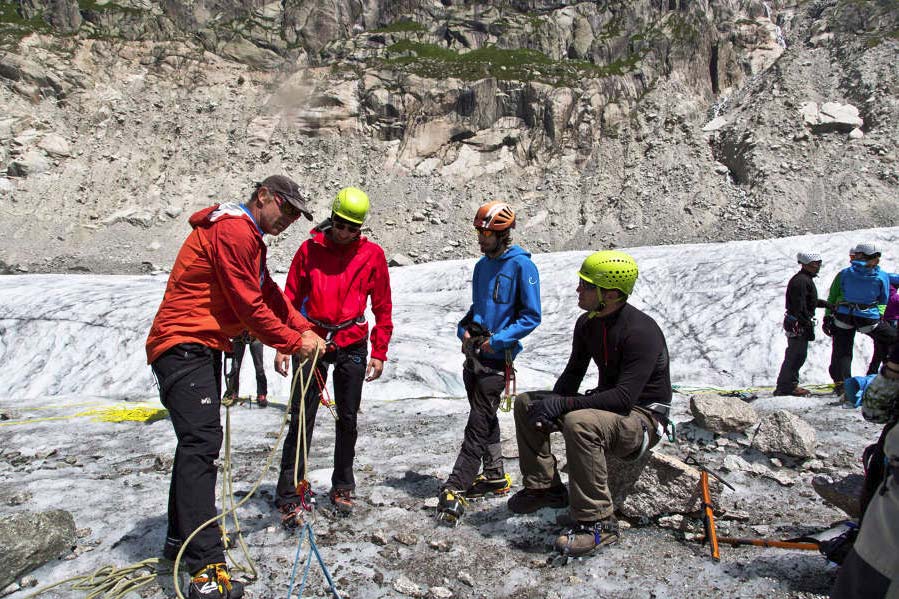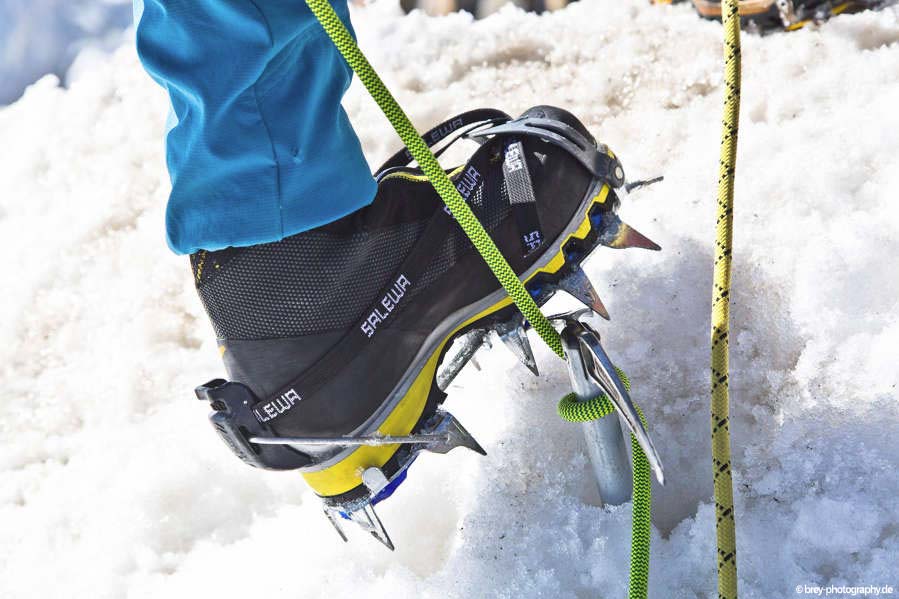The mighty Mont Blanc has captured the imagination of climbers for centuries and each year continues to draw mountaineers from all over the world.

Climb the Mont Blanc in France!
At 4810 m the Mont Blanc is Western Europe’s highest mountain. It’s nearly 200 m higher than Switzerland’s Monte Rosa, the second highest mountain in the Alps. Dominating the climbing mecca of Chamonix, a successful ascent is a hugely rewarding experience and the Mont Blanc should be on every keen climber’s bucket list.
Mont Blanc summit climbing trips can take anything from 2 to 6 days depending on your fitness, level of acclimatisation and high altitude mountaineering experience.
For most people a 5 or 6 day trip works well and gives you the best chance of reaching the summit. You spend a couple of days acclimatising and practising ice axe and crampon techniques on the Mer de Glace. The summit is then attempted over 2 days, usually via the Gouter or Cosmiques routes, with the best weather window chosen for the final push.
To build confidence and help with acclimatisation, some mountaineering companies will also include a warm-up peak like the Tête Blanche. The traverse via the east and north-west ridges provides a good introduction to PD Alpine mountaineering.
Rated PD on the Alpine Grades scale, the Mont Blanc via the Normal Route isn’t a very technical climb, but it does require sustained effort at high altitude. Summit day can be as long as 13 hours, so you need to be in good shape to enjoy the climb. The first few hours in the dark are very tough. Until the sun comes up, you’ll be walking in freezing temperatures with a head torch. The guides take it slowly, but with strong winds, your backpack weighing you down and the steep terrain, be under no illusion, it’s seriously hard work.
The key to success is preparation and acclimatisation. Although the normal route to the summit isn’t technical, it does require sustained physical effort. Make sure you get plenty of training walks in before your trip and aim for one or two longer days in the mountains during the month before your trip. Despite the fact that a 5 day trip will include some ice and snow climbing practice, guides can’t cater for complete beginners in that time-frame and it’s recommended that you have some high altitude mountaineering experience and know how to use your kit prior to joining a Mont Blanc expedition.
Book a Mont Blanc mountaineering trip
Our mountaineering partners offer Mont Blanc summit ascents from 2 to 6 days depending on your level of experience and acclimatisation. If you want to stand the best chance of conquering the summit, it’s a really good idea to employ a high altitude mountain guide. All the companies listed here use fully qualified UIAGM mountain guides. They’ll be able to vary the route and rate of ascent to your ability, navigate in bad weather and keep you safe on steep snow and ice.
Different packages are available from 2 day straight ascents to 5 and 6 day mountaineering courses that include snow and ice climbing instruction and acclimatisation. Whichever package you choose, the guides all have one goal, to get you to the summit and back down again safely. Typically, a 5-day Mont Blanc trip will cost upwards of 1200 € per person, including accommodation, food and guiding, and excluding insurance, drinks, and personal equipment. Take a guide, you’ll be safer and you’ll have a lot more fun.
[sabai-directory-listings category=mountaineering featured_only=1 hide_nav=1]
Mont Blanc Routes

On the summit of Mont Blanc | © Odysee Montagne
There are 2 different routes to climb Mont Blanc from Chamonix – the Normal Route via the Gouter Refuge and the Cosmiques route via Mont Blanc du Tacul and Col Maudit. Overall, both routes are just as demanding. The Gouter route has a longer first day and a shorter second day, while the Cosmiques route is the opposite. The Cosmiques route is also a bit more technically demanding with with a steep slope of 150 m on the Mont Maudit. Be aware that the Gouter route is busy throughout the summer and the mountain hut gets booked up early. For that reason, availability in the refuges may dictate your itinerary.
Gouter Route
Day 1: Climb to the Gouter Refuge (3800 m) + 1500 m – 5/6h
Day 2: Mont Blanc summit ascent via the Dôme du Gouter +1000 m, -2500 m, 10-12 hours
Cosmiques Route
Day 1: Short walk to the Cosmiques hut (3600m) 40 mn. In the evening snow training on glacier and rest.
Day 2: Tacul, Col du Maudit, Montt Blanc +1400 m, -2500 m, 10-12 hours
The Italian Side
If you want to ramp up the adventure and climb a longer, more challenging route, summiting from the Italian side is a great option. You’ll start in Val Veny and climb via the Gonella mountain refuge, following the Aiguilles Grises route. The path is less trodden and it feels wild. Although it’s not technically difficult, this routes remoteness means it’s only recommended for experienced mountaineers.
Day 1: from Val Veny in Italy climb to Gonella mountain hut. +1400 m 6 hours
Day 2: ascent of Mt Blanc by the Aiguille Grises ridge. +1800 m 12 hours
Mont Blanc 5-Day Mountaineering Course

Ice climbing instruction on the Mer de Glace | © brey-photography.de
If you don’t have much high altitude mountaineering experience, this course is ideal. It gives you chance to acclimatise and build confidence in a mountainous environment whilst reinforcing snow and ice climbing skills. Days 4 and 5 are dedicated to the ascent itself. A 6-day trip will include an extra night on the mountain on the way down, and provide a broader weather window if conditions are poor.
Days 1-3: Expect a mix of snow and ice climbing training on the glacier with glacier hiking and warm-up summit ascents. Depending on the conditions and the group’s ability, your guide will decide on the area for the training. Le Tour, Argentière and Miage in the Chamonix Valley each offer straightforward snow climbs. You’ll spend 2 nights in high altitude refuges to aide acclimatisation. The third night is typically spent back down in the Chamonix Valley in preparation for the Mont Blanc summit ascent.
Day 4: Climb to either the Cosmiques or Gouter refuge.
Day 5: Ascent of the Mont Blanc and back to Chamonix.
Mont Blanc Ascent FAQs
[su_box]
What’s the best time of year to climb the Mont Blanc?
Most mountaineering companies operate Mont Blanc ascents between June and September. Summer offers the best weather conditions for a summit attempt and although ever-present, the avalanche risk is reduced. Typically, trips will run weekly starting on either Saturday or Sunday.
How experienced do I need to be?
The final ascent of Mt Blanc is very demanding and you can expect to spend 12 hours climbing at high altitude. You don’t need to have any previous snow and ice climbing experience to join this course, but some experience is helpful. It’s essential to have a good level of fitness. As a guide, you should be able to climb 1000 m at 350 m per hour.
How risky is the ascent?
The Mont Blanc via the normal route isn’t technically difficult, but there are still a number of risks associated with high altitude mountaineering. There are 80 to 100 rescues carried out every year, sometimes several separate rescues in a single day. 80% of rescues are due to exhaustion as a result of lack of physical fitness or poor acclimatisation.
Natural hazards are ever-present – avalanches, falling seracs, rockfalls, storms, high winds, poor visibility, etc. Rockfalls are a particular hazard on the Gouter route and there are several fatalities each year.
What’s the mountain accommodation like?
In the mountain huts, it’s dormitory accommodation. They’re not as comfortable as a hotel, but they’re perfectly adequate. After a long day battling a cold wind on the mountain, they provide a welcome respite. They can be noisy at night, so bring earplugs if you’re a light sleeper. Evening meals are hearty and designed to fuel you up ready for another hard day on the mountain.
Any tips for the summit attempt on Mont Blanc?
Tape up your heels as you want to avoid blisters during the 13 hour trek. It gets very cold above 4000 m and you’ll almost certainly need mittens – they keep your hands a lot warmer than ski gloves. If its windy up there, ski goggles are essential – sunglasses aren’t good enough in high winds. Keep your camera in a warm fleece pocket as it may not work in the cold. Take a water bottle instead of a hydration bladder for the summit, or make sure your Camelbak is well insulated as temperatures can get down as low as -20 and the tube will freeze.
How qualified is the guide for the ascent?
Make sure your guide is a UIAGM qualified high mountain guide. Training days are generally undertaken by 1 high mountain guide per group of approx 6 people. For the summit ascent, the ratio is reduced to 1 guide for every 2 people. You’re guide’s main aim is to get you to the summit whilst keeping you safe. Weather conditions, avalanche risk and the group’s fitness and ability all affect decision making and your guide may change the route if necessary.
Will I need both Swiss Francs and Euros?
You don’t need to bring both currencies as the places you visit in Switzerland will take Euros. However, you may not get a particularly favourable exchange rate, but you won’t need to spend much when over the border so the difference is minimal. Allow about 200 € to cover cable cars and any extras like snacks and drinks.
Do I need upgraded travel insurance?
Yes, it is your responsibility to make sure your insurance covers you for mountaineering and includes helicopter rescue and repatriation.
[/su_box]
Mont Blanc Mountaineering Kit List
Climbing the Mont Blanc is a high altitude mountain expedition and you can face high winds and temperatures as low as -20 °C. To enjoy the trip and give yourself the best chance of reaching the summit, you need to bring the right gear.
Clothing wise, you’ll need good technical trekking and mountaineering layers including thermal base layers, wind proof mid-layer and breathable waterproof jacket and trousers. Several thin layers are preferable so you can adjust your clothing according to the weather conditions. Also essential are walking socks, a warm hat that covers your ears and mittens rather than gloves. Ski goggles are better than sunglasses in cold, windy conditions.
Bring a sleeping bag liner for the mountain huts, a lightweight technical 40 litre backpack and walking poles, given the gradient of the trek.
There are plenty of options for hiring good quality gear in Chamonix. Ravanel & Co, Sanglard Sports and Cham3S in Chamonix each have technical mountaineering kit for hire and you can pre-book your gear online.
[su_box]
[su_row][su_column]
Clothing
Warm fleece hat
Sun hat
Thermal underwear
Fleece mid layers
Breathable waterproof jacket
Breathable waterproof trousers
Mountain gloves or mitts
Thin fleece windproof gloves
Thick walking socks
Gaiters
Mountaineering boots
Goggles
Sunglasses
Accessories
Head torch and spare batteries
40 mountaineering litre backpack
Water bottle or hydration bladder
High factor mountain sun screen
Telescopic walking poles
Harness, crampons, ice axe, helmet
(can be rented in Chamonix)
[/su_column][su_column]
First aid kit
Blister kit
Pain killers (aspirin or paracetamol)
Anti inflammatories (ibuprofen)
Anti-sceptic cream
Crepe bandages
Documents & Money
Passport or ID card
Alpine Club card
Approx 200 € cash
Technical Equipment Rental
For mountaineering boots, harness, ice axe, helmet and crampons expect to pay approx 90 € for 5 days.
For GoreTex jacket & trousers expect to pay approx 90 € for 5 days.
[/su_column][/su_row]
[/su_box]
Please leave a comment below if you need specific advice for your Mont Blanc Ascent, or if you have any recommendations to help us improve this guide. Good luck!


Do you have any space for Mont Blanc 5 days in September?
Hi Camilla, thanks for your message! Great to hear you’re planning a Mont Blanc trip. We don’t actually run the trips ourselves but we can recommend reliable guides. You can try contacting Sandrine at Odyssee Montagne, hopefully they’ll have some availability in September: https://www.odyssee-montagne.fr/mont-blanc
Hope this helps. Good luck planning your trip!
Matt